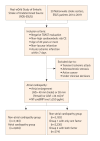Atrial Cardiopathy Worsens Neurological Severity, Raises Recurrence Rates, and Leads to Poor Vascular Outcomes in Patients With Embolic Stroke of Undetermined Source
- PMID: 41084290
- PMCID: PMC12527577
- DOI: 10.5853/jos.2025.00906
Atrial Cardiopathy Worsens Neurological Severity, Raises Recurrence Rates, and Leads to Poor Vascular Outcomes in Patients With Embolic Stroke of Undetermined Source
Abstract
Background and purpose: Atrial cardiopathy (AC) has been studied for its significance in embolic stroke of undetermined source (ESUS). This real-world study examines the relevance of AC in ESUS and its impact on stroke severity, recurrence, and major adverse cardiovascular events (MACEs).
Methods: We analyzed patients from stroke registries of South Korean centers (2014-2019) aged ≥20 years with acute ESUS or cardiogenic stroke without a definite embolic source. AC was defined by left atrial (LA) enlargement (diameter >40 mm in men and >38 mm in women; or LA volume index >34 mL/m2) or elevated N-terminal pro-B-type natriuretic peptide (NT-proBNP, ≥250 pg/mL) levels. Patients were classified based on AC presence and stratified by the number of factors (AC groups 0, 1, and 2). Survival analysis in original and propensity score (PS)-matched cohorts assessed the impact of AC on stroke severity and vascular outcomes.
Results: Among 5,787 patients (65.9±13.9 years; female: 39.8%), 45.0% met the AC criteria (group 1: 40.3%, group 2: 4.7%). In the original cohort, AC group 2 was associated with increased stroke recurrence (hazard ratio [HR]: 1.76, 95% confidence interval [CI]: 1.06-2.92, P=0.03). After PS-matching, stroke recurrence remained significantly increased for AC (HR: 1.37, 95% CI: 1.04-1.79, P=0.02) and group 2 (HR: 1.94, 95% CI: 1.16-3.26, P=0.01). MACE outcomes increased in the group 2 patients (HR: 1.70, 95% CI: 1.07-2.70, P=0.02). NT-proBNP (HR: 0.97, 95% CI: 0.84-1.12, P=0.69) or LA enlargement (HR: 1.15, 95% CI: 0.89-1.49, P=0.28) alone were not predictive. AC correlated with longer hospital stays, and AC stratification with higher severity.
Conclusion: Especially with multiple factors, AC was associated with adverse clinical outcome in patients with ESUS. These findings underscore the importance of AC stratification in the management of ESUS patients.
Keywords: Atrial cardiopathy; Atrial remodeling; Cardiomyopathies; Cardiovascular diseases; Ischemic stroke; Major adverse cardiovascular event.
Conflict of interest statement
The authors have no financial conflicts of interest.
Figures



References
-
- Hart RG, Diener HC, Coutts SB, Easton JD, Granger CB, O’Donnell MJ, et al. Embolic strokes of undetermined source: the case for a new clinical construct. Lancet Neurol. 2014;13:429–438. - PubMed
-
- Ntaios G, Pearce LA, Veltkamp R, Sharma M, Kasner SE, Korompoki E, et al. Potential embolic sources and outcomes in embolic stroke of undetermined source in the NAVIGATE-ESUS trial. Stroke. 2020;51:1797–1804. - PubMed
-
- Diener HC, Sacco RL, Easton JD, Granger CB, Bernstein RA, Uchiyama S, et al. Dabigatran for prevention of stroke after embolic stroke of undetermined source. N Engl J Med. 2019;380:1906–1917. - PubMed
Grants and funding
LinkOut - more resources
Full Text Sources
Research Materials
Miscellaneous

